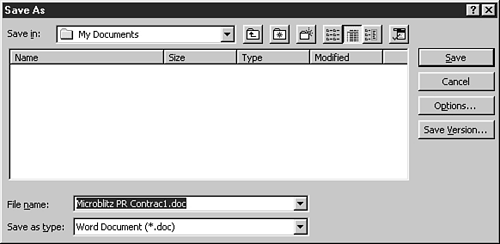Computers Make It Easy to Get into Trouble
| Computers that sit on a desk simply behave in the same, irritating way computers always have, and they don't have to be crossed with anything. My friend Jane used to work in public relations as an account coordinator. She ran Windows 95 on her desktop PC, using Microsoft Word to write memos and contracts. The core of Windows 95 is the hierarchical file system. All of Jane's documents were stored in little folders, which were stored in other little folders. Jane didn't understand this or see the advantage to storing things that way. Actually, Jane didn't give it a lot of thought but merely took the path of least resistance.
Jane had just finished drafting the new PR contract for a Silicon Valley startup company. She selected Close from the File menu. Instead of simply doing as she directed and closing the document, Word popped up a dialog box. It was, of course, the all-too-familiar Do You Want to Save the Changes? confirmation box. She responded as always by pressing the Enter key. She responded this way so consistently and often that she no longer even looked at the dialog box.
The first dialog box was followed immediately by another one, the equally familiar Save As box. It presented Jane with lots of confusing buttons, icons, and text fields. The only one that Jane understood and used was the text-entry field for File Name. She typed in a likely name and then clicked the Save button. The program then saved the PR contract in the My Documents folder. Jane was so used to this unnecessary drill that she gave it no thought. At lunchtime, while Jane was out of her office, Sunil, the company's computer tech, installed a new version of VirusKiller 2.1 on her computer. While working on Jane's PC, Sunil used Word to view a VirusKiller Readme file. After viewing the file, Sunil closed it and returned Jane's computer to exactly the way it was before lunch. At least, he thought he did. After lunch, Jane needed to reopen the PR contract and get a printout to show to her boss. Jane selected Open from the File menu, and the Open dialog box appeared. Jane expected the Open dialog box to show her, in neat alphabetic order, all of her contracts and documents. Instead, it showed her a bunch of filenames that she had never seen before and didn't recognize. One of them was named Readme.doc. Of course, when Sunil used Word to view the Readme file, he instructed Jane's copy of Word to look in an obscure folder six levels deep and inadvertently steered it away from Jane's normal setting of My Documents. Jane was now quite bewildered. Her first, unavoidable thought was that all of her hard work had somehow been erased, and she got very worried. She called over René, her friend and co-worker, but René was just as confused as Jane was. Finally, in a state approaching panic, Jane telephoned Sunil to ask for his help. Sunil was not at his desk, and it wasn't until Monday morning that he had a chance to stop by and set things right. Jane, René, Sunil and the PR company each lost a half-day's productivity. Although computer operating systems need hierarchical file systems, the people who use them don't. It's not surprising that computer programmers like to see the underlying hierarchical file systems, but it is equally unremarkable that normal users like Jane don't. Unremarkable to everyone, that is, except the programmers who create the software that we all use. They create the behavior and information presentation that they like best, which is very different from the behavior and information presentation that is best for Jane. Jane's frustration and inefficiency is blamed on Jane, and not on the programmers who torpedoed her. At least Jane has a job. Many people are considered insufficiently "computer literate" and are thus not employable. As more and more jobs demand interaction with computers, the rift between the employable and the unemployable becomes wider and more difficult to cross. Politicians may demand jobs for the underprivileged, but if the underprivileged don't know how to use computers, no company can afford to let them put their untrained hands on the company's computers. There is too much training involved, and too much exposure to the destruction of data and the bollixing up of priceless databases. The obnoxious behavior and obscure interaction that software-based products exhibit is institutionalizing what I call "software apartheid": Otherwise-normal people are forbidden from entering the job market and participating in society because they cannot use computers effectively. In our enlightened society, social activists are working hard to break down race and class barriers while technologists are hard at work inadvertently erecting new, bigger ones. By purposefully designing our software-based products to be more human and forgiving, we can automatically make them more inclusive, more class- and color-blind. |
EAN: N/A
Pages: 170

